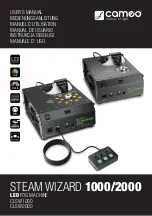
- 6 -
5.
MAIN MOTOR CONTROL
The main motor for the sewing machine is required to smoothly change from low speed to high speed without any
fluctuations due to load or temperature changes. To fully comply with this requirement, the PE-300S adopts
PWM control using FET.
6.
PATTERN GENERATOR
For conventional sewing machines of the past, the pattern was generated by rocking the needle bar and the feed
regulator by means of a pattern cam onto which the pattern data had been mechanically engraved. In contrast to
this, the PE-300S stores the data electronically in memory and uses a zigzag pulse motor to directly rock the
needle bar and the feed gear to generate the pattern. In addition, the pulse motors must move the position of the
needle while the needle is raised and stop it in the correct position (and similarly, they must move the position of
the feed gear while the needle is lowered) , thus highly-precise positioning and a fast response speed are
required. For this reason, PM feed and zigzag pulse motors were adopted, and a simple open-loop circuit
structure was employed.
Block diagram of pattern generator control
7.
OTHER ELECTRONIC COMPONENT FUNCTIONS
Start/stop switch .................................. Used to start and stop (SS) the machine. If you want to start sewing at low
speed, keep this switch depressed and start sewing.
Backstitch switch ................................. Used for backstitching and lockstitching. Backstitching is performed at low
speed in the reverse direction while the switch is pressed. For
lockstitching, three stitches are made at the current needle position and
then sewing stops.
Needle position (UP/DOWN) switch .... Used to change the needle position either up ro down.
Touch panel......................................... Used to select pattern and input test mode number required for sewing. by
This simply touching the display on the panel. This simplifies the operation
for selecting the desired pattern and number.
Buttonhole stitch switch ....................... Used to detect the edges of the buttonhole stitch by means of the
buttonhole stitch presser foot and lever.
Buttonhole stitch lever switch .............. Used to detect whether the buttonhole stitch lever is raised or lowered.
Rotation sensor ................................... Detects the vertical position of the needle and the drive timing of the
zigzag and feed pulse motors.
Detects the turning angle by means of a photointerrupter and shutter
installed on the vertical shaft.
Speed sensor ...................................... Used to detect the rotation speed of the main motor.
Detects the operating speed of the main motor by means of a
photointerrupter and shutter installed on the idle pulley.
Bobbin winder switch ........................... Used to detect whether the bobbin winder has been set when windingthe
lower thread.
Junction foot controller ........................ When using the foot controller, connect it to this terminal.
Transformer......................................... Used for driving the pulse motors and solenoids, to illuminate the lamps
and to supply power to the electronic circuitry.
Lamp.................................................... is 12V 5W.
Summary of Contents for PE-300S
Page 1: ... 2 1999 ...
Page 4: ... 2 1 MECHANICAL CHART EMBROIDERY UNIT MECHANISM ...
Page 6: ... 4 3 ELECTRONIC PARTS ARRANGEMENT CHART ...
Page 7: ... 5 4 CONTROL SYSTEM BLOCK DIAGRAM ...
Page 11: ... 9 9 1 1 9 9 8 7 7 3 3 6 6 2 2 3 1 1 9 5 5 5 ...
Page 13: ... 11 12 11 17 20 20 15 16 19 20 18 13 14 10 10 ...
Page 15: ... 13 25 2 25 1 23 36 29 29 37 32 22 22 24 24 27 27 30 30 31 31 33 33 34 32 28 36 35 26 ...
Page 17: ... 15 39 39 38 ...
Page 19: ... 17 Diagram A 45 1 45 2 42 53 48 52 49 50 43 42 41 44 47 47 46 40 51 ...
Page 21: ... 19 Diagram A 55 60 56 54 58 64 64 65 61 61 59 59 54 57 ...
Page 23: ... 21 diagram A 74 69 69 68 69 75 73 72 70 67 67 ...
Page 25: ... 23 77 78 84 68 84 78 78 79 86 86 84 ...
Page 27: ... 25 5 3 2 2 2 2 3 4 1 5 ...
Page 28: ... 26 3 LEAD WIRE ARRANGEMENT ...
Page 57: ...PE 300S H8080132 ...









































